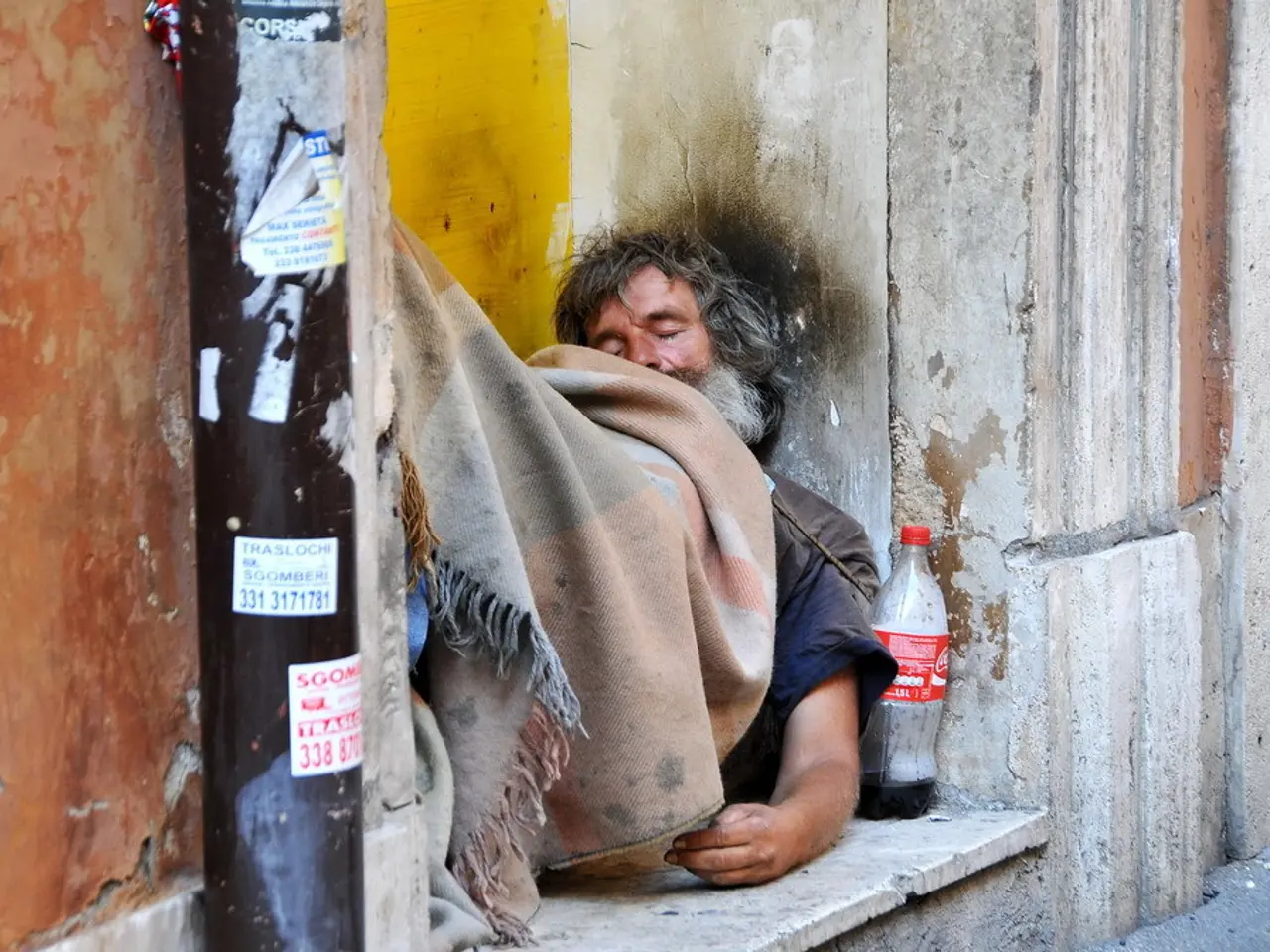Indoor and Outdoor Settings Equally Susceptible to Hypothermia
In the cold winter months, it's essential to be aware of the dangers of hypothermia, a potentially life-threatening condition caused by a drop in body temperature. This condition is not just a concern for those exposed to extreme cold temperatures, but it can also affect individuals in less extreme conditions, especially certain vulnerable groups.
Hypothermia is a medical emergency that requires immediate attention. Symptoms in infants and children may include cold, bright red skin, low energy, and confusion. In adults, symptoms may include shivering, memory loss, slurred speech, confusion, and exhaustion. However, hypothermia can also present with seemingly milder symptoms such as drowsiness, fumbling hands, and dizziness.
The risk of hypothermia is not solely dependent on ambient cold. Several factors contribute to the development of this condition. Prolonged exposure to cold environments, surgeries, or lower environmental temperatures can increase the risk, as the body may lose heat over time and be unable to compensate. Conditions that impair heat production or retention, such as reduced metabolism, low muscle activity, or poor vasomotor responses, also raise the risk.
Immersion in cold water causes rapid heat loss and triggers a gasp reflex, increasing the risk of complications beyond hypothermia. Chilling, even before clinical hypothermia develops, can lower muscle strength, dexterity, and cognitive function, increasing accident risk and worsening outcomes.
Certain groups are at greater risk of hypothermia. These include older adults, young children, and people with inadequate heat, food, and clothing. Age, medical conditions such as dementia, hypothyroidism, low blood sugar, high blood pressure, certain medications, dehydration, strenuous outdoor activities, and alcohol or drug use can also increase the risk.
Prevention is key in avoiding hypothermia. Wearing dry, warm clothing, including a hat, during cold weather is crucial. It's also important to stay dry and avoid excessive sweating, as wet clothing can hasten heat loss.
Education and awareness are vital in preventing hypothermia-related deaths. Thousands of people die each year in the United States from hypothermia, and many of these deaths are preventable. By understanding the risk factors and taking appropriate precautions, we can help protect ourselves and others from this potentially fatal condition.
- In the midst of winter's icy grip, it's crucial to stay vigilant about hypothermia, an alarming medical condition brought on by a decline in body temperature.
- This condition poses a threat not only to those in extremes of cold climates, but also to individuals in less drastic conditions, particularly vulnerable groups.
- Hypothermia is considered a medical emergency that demands prompt attention. In newborns and children, symptoms such as rosy, cold skin, low energy, and confusion may arise.
- With adults, symptoms like shivering, memory loss, slurred speech, confusion, and fatigue could be seen. However, hypothermia can also display symptoms as seemingly mild as sleepiness, shaky hands, and lightheadedness.
- The danger of hypothermia is not solely determined by the cold surrounding you. Multiple factors contribute to its onset. Exposure to cold environments, surgical procedures, or lower ambient temperatures can elevate the risk, as the body may lose heat progressively and struggle to compensate.
- Conditions that hamper heat production or preservation, like slower metabolism, low muscle activity, or poor vasomotor responses, also increase the threat.
- Immersing in cold water induces swift heat loss and triggers a gasping reflex, amplifying the likelihood of complications beyond hypothermia. Chilling, even before clinical hypothermia manifests, can weaken muscle strength, agility, and cognitive function, enhancing accident risk and exacerbating outcomes.
- Several groups harbor a higher susceptibility to hypothermia. These involve older adults, young children, and people confronted with inadequate heating, food, and clothing.
- Age, underlying medical conditions such as dementia, hypothyroidism, low blood sugar, high blood pressure, certain medications, dehydration, laborious outdoor activities, and drug or alcohol abuse can also intensify the risk.
- Steering clear of hypothermia is essential. Wearing dry, warm clothing, including a hat, during cold weather is essential. Remaining dry and avoiding excessive sweating, as wet clothing can accelerate heat loss, is vital.
- With the right education and awareness, hypothermia-related fatalities can be reduced significantly. Thousands perish annually in the United States due to hypothermia, with many of these deaths being preventable.
- By comprehending the risk elements and implementing suitable precautions, we can help safeguard ourselves and others from this potentially lethal condition.
- When it comes to a healthy lifestyle, hypothermia prevention is a vital part of workplace wellness programs – ensuring employees remain protected and productive during cold winter months.
- Medical conditions like diabetes and chronic heart disease can weaken the body's ability to register cold temperatures, heightening the risk of hypothermia.
- Science and environmental science researchers are focusing on the consequences of climate change on health, including the potential rise in cases of hypothermia and other respiratory conditions due to increased cold temperatures.
- In the world of finance, investments in eco-friendly industries can contribute to the preservation of a healthier environment and the reduction of health risks related to hypothermia and climate change.
- Autonomous cars equipped with heating systems and smart technology are developments in the automotive industry specifically aimed at preventing hypothermia-related complications while driving in cold weather.
- Hearing about extreme weather warnings on medical channels or through apps can help people remain informed and better prepare for cold spells that may pose a risk of hypothermia.
- In the realm of fashion and beauty, thermal wear and waterproof clothing are crucial for maintaining body heat and preventing hypothermia during winter activities like skiing and hiking.
- To preserve eye health, wearing sunglasses in snowy weather can shield your eyes from harmful UV rays that can lead to cataracts or other eye conditions.
- When attending to pets during cold weather, ensuring they have adequate shelter, food, and water is vital for their well-being and to safeguard them against hypothermia and hypothermia-related complications.
- Therapies and treatments such as acupuncture and massage can boost the body's overall functioning, which may help regulate body temperature and prevent hypothermia.
- As people age, their bodies become less capable of regulating temperature, increasing their risk of developing hypothermia. Regular checkups and monitoring can help identify any underlying conditions that may heighten the risk.
- Women are more likely to experience hormone fluctuations that impact their body's ability to maintain a consistent temperature. Women's health initiatives focused on cold weather awareness and precautions are essential to prevent hypothermia and better protect women during the winter months.
- Men's health initiatives centered around outdoor activities and sports should equally concentrate on cold weather preparedness, as men are at a higher risk of hypothermia due to their frequent involvement in outdoor activities.
- Skin health is an aspect that tends to be neglected during winter, but ensuring proper hydration and applying moisturizing lotions can help maintain skin health and reduce the risk of skin conditions exacerbated by cold weather.
- In the digital age, using apps and social media platforms that disseminate weather updates, safety tips, and cold weather precautions can help people remain informed and protected.
- The healthcare industry is researching advanced means of diagnosing and treating hypothermia, like hypothermia-specific rapid response units or mobile medical units deployed during extreme weather events.
- Mental health is a crucial aspect of overall health, and seasonal affective disorder is a condition that may be triggered by cold weather and exposure to less sunlight. Therapies and counseling can help monitor and manage this condition.
- Pets, too, can experience mental health issues during winter, such as increased anxiety or depression due to isolation. Providing adequate exercise and companionship can help alleviate these concerns.
- With people spending more time at home due to the pandemic, home and garden enthusiasts are focusing on creating efficient heating systems, insulation, and energy-efficient appliances to reduce energy bills, maintain a comfortable temperature, and prevent hypothermia.
- The rise of telehealth services during the pandemic has made it easier for people to consult with doctors about cold weather safety, health concerns, and prevention strategies for conditions like hypothermia.
- The travel industry is encouraging tourists to research climate, weather, and health-related conditions before embarking on their journeys, particularly to cold weather destinations.
- The entertainment industry is producing content that enlightens the public about health and wellness during winter, from informative documentaries about winter safety, to engaging movies and TV shows that showcase healthy lifestyles and responsible winter choices.
- Climate change and the warming of our planet's temperature have the potential to disproportionately impact countries in the Southern Hemisphere during their winter months, leading to an increased threat of respiratory conditions like hypothermia.
- With the growing concern about the environmental impact of certain chemicals, food and drink industries are working to reduce or eliminate harmful substances found in packaging or ingredients that may exacerbate digestive health issues or allergies in winter.
- In the realm of finance, investing in companies that prioritize environmental sustainability, health and wellness, cybersecurity, and technological advancement can help create a healthier and safer world for everyone, mitigating the risk of hypothermia, climate change, and other health concerns.
- The future of healthcare entails a shift towards holistic and preventive care, including chronic diseases and mental health conditions, promoting a healthier lifestyle, and reducing the risk of hypothermia and other weather-related health issues.
- By remaining informed about weather patterns, supportive of one another, and implementing proactive measures to stay protected, we can all contribute to a healthier, safer, and happier winter season.




